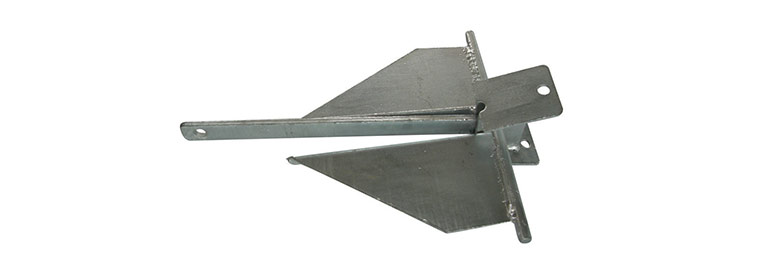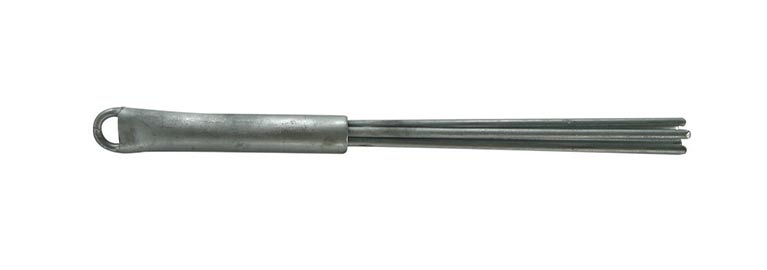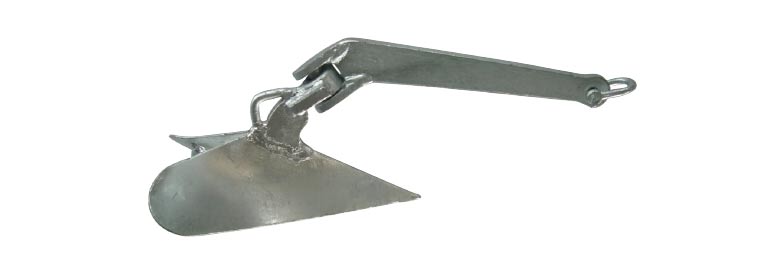Anchors
Sand Anchor
Sand anchors are a self-setting anchor, designed primarily for use on soft sea floors. Sand, mud and gravelly bottoms are all perfect candidates. Once deployed, the sand anchor buries itself down creating a fixed point to hold the vessel in position. Sand anchors are commonly used on trailer boats, it’s just a matter of picking the corresponding size to suit your vessel.
Avoid using these anchors in reefy or rocky areas, once the digging blades catch on a solid structure they can be very difficult to free. To avoid anchor losses, rig as a breakaway set up with the chain connected via a de-shackle to the top of the anchor then zip-tied to the end of the anchors arm. In the event of a snagging the zip-tie will break and allow the anchor to be pulled out backwards. Shop Sand Anchors

Reef Pick / Grapple Anchor
Another very popular style of anchor for trailer boat users. The grapple hook style anchor is ideal for grabbing hold on rough, hard terrain. Its long-hooked fingers enable it to lock into bottom, where other anchors would just skip across, or permanently jam. The reef pick is designed to have its prongs straighten out when placed under excessive load, making the retrieval process a lot easier. Shop Reef Pick / Grapple Anchors

Folding Anchors
Aimed for use by smaller vessels, ie tenders, small tinnys and kayaks, the foldable anchor offers a very portable and compact anchoring option. Primarily for use on soft bottoms, the foldable anchor can also be used on some hard terrains, but, keep in mind the talons cannot be straightened or bent. Be sure to rig with a breakaway zip tie similar to the sand anchor. Shop Folding Anchors

Plough Anchors
Plough anchors are designed for use in areas with soft bottoms, that receive a lot of tidal movement or current. They are also able to be used on hard terrain with the use of the break-away rigging method. They are a very secure anchor that buries itself deep into the bottom to prevent dragging.
The articulated arm takes away any sideways pressure from the boat making it a lot more reliable for long term anchoring. Retrieval of plough anchors is easiest done with an anchor winch, often it takes quite a bit of force to free them. The downside of the plough anchor is that it is quite bulky and hard to store. Shop Plough Anchors

Accessories
Chains
The chain plays an essential role in the functionality of the anchor. Not only does it provide weight to help lower the direction of pull from the boat above, but it also provides abrasion resistance rather than having the rope rubbing against rocks and sharp reef. As a general rule, the chain length should be equal or more then the length of the boat.
Expert Tip
If you're trying to keep your presence super stealth, or don’t like bare chain banging around your boat, try threading a bicycle tube over the chain. This will dampen the noise and provide protection for the hull.
Anchor Buoy
Anchor buoys are a must have accessory for boaties who intend on anchoring in deep water without an anchor winch. By clipping the buoy onto the main anchor rope and driving in an ark back towards the anchor, the water pressure pushes the buoy down the rope towards the freed anchor and brings it to the surface. Once there, all that’s left is to pull the rope in across the top of the water. A job made a lot easier than busting your gut pulling it up from the depths.
D-shackles
The most overlooked part of an anchoring system, the d-shackles. D-shackles are required to connect the chain to the rope and the anchor to the chain. They provide a strong and robust connection which should never fail if treated correctly.
Before deploying the anchor, always ensure the shackle pins are tightened up with a pair of pliers and use a piece of light wire to wire the pin to the d-shackle itself. This will prevent the pin from coming loose after long periods of movement and pressure changes as the boat rocks around on the surface.






